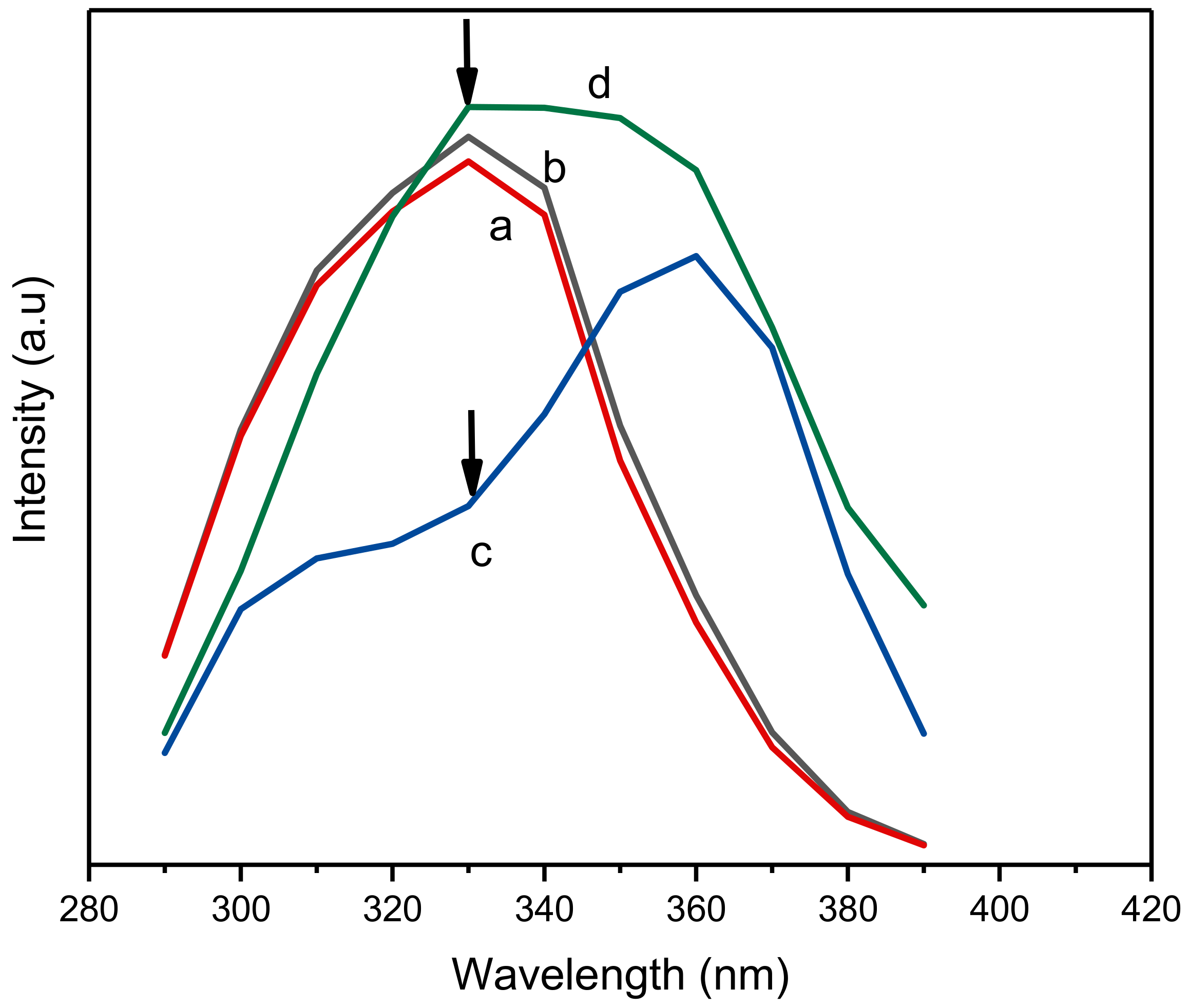Molecularly Imprinted Polymers/Metal–Organic Framework (MIL-53) for Fluorescent Sensing of Ciprofloxacin in Water †
Abstract
:1. Introduction
2. Materials and Method
2.1. Materials
2.2. Synthesis of NH2-MIL-53(Al)
2.3. Synthesis of NH2-MIL-53(Al)/MIP
2.4. Fluorescence Detection of Ciprofloxacin
2.5. Characterization of NH2-MIL-53(Al) and NH2-MIL-53(Al)/MIP
3. Results and Discussion
4. Conclusions
Author Contributions
Funding
Institutional Review Board Statement
Informed Consent Statement
Data Availability Statement
Acknowledgments
Conflicts of Interest
References
- Antimicrobial Resistance. 2021. Available online: https://www.who.int/news-room/fact-sheets/detail/antimicrobial-resistance (accessed on 19 March 2023).
- Tyulenev, A.V.; Smirnova, G.V.; Muzyka, N.G.; Oktyabrsky, O.N. Study of the early response of Escherichia coli lpcA and ompF mutants to ciprofloxacin. Res. Microbiol. 2022, 173, 103954. [Google Scholar] [CrossRef] [PubMed]
- Watcharadulyarat, N.; Rattanatayarom, M.; Ruangsawasdi, N.; Patikarnmonthon, N. PEG–PLGA nanoparticles for encapsulating ciprofloxacin. Sci. Rep. 2023, 13, 266. [Google Scholar] [CrossRef] [PubMed]
- Zhang, H.; Quan, H.; Yin, S.; Sun, L.; Lu, H. Unraveling the Toxicity Associated with Ciprofloxacin Biodegradation in Biological Wastewater Treatment. Environ. Sci. Technol. 2022, 56, 15941–15952. [Google Scholar] [CrossRef] [PubMed]
- Zhu, J.; Wang, H.; Duan, A.; Wang, Y. Mechanistic insight into the degradation of ciprofloxacin in water by hydroxyl radicals. J. Hazard. Mater. 2023, 446, 130676. [Google Scholar] [CrossRef] [PubMed]
- Liu, X.; Wang, T.; Lu, Y.; Wang, W.; Zhou, Z.; Yan, Y. Constructing carbon dots and CdTe quantum dots multi-functional composites for ultrasensitive sensing and rapid degrading ciprofloxacin. Sens. Actuators Chem. 2019, 289, 242–251. [Google Scholar] [CrossRef]
- Munir, F.; Waseem, M.T.; Khan, Z.A.; Majeed, S.; Farooq, U.; Shahzad, S.A. Synthesis of AIEE active triazine based new fluorescent and colorimetric probes: A reversible mechanochromism and sequential detection of picric acid and ciprofloxacin. J. Photochem. Photobiol. Chem. 2022, 429, 113921. [Google Scholar] [CrossRef]
- Wang, H.; Qian, X.; An, X. Tb-coordination polymer-anchored nanocellulose composite film for selective and sensitive detection of ciprofloxacin. Carbohydr. Polym. 2022, 287, 119337. [Google Scholar] [CrossRef] [PubMed]
- An, X.; Zhu, X.; Liu, J.; Zou, L.; Li, G.; Ye, B. Ratiometric fluorescence detection of ciprofloxacin using the terbium-based coordination polymers. Spectrochim. Acta Part A Mol. Biomol. 2022, 269, 120775. [Google Scholar] [CrossRef] [PubMed]
- Singha, S.; Ahn, K.H. Detection of Ciprofloxacin in Urine through Sensitized Lanthanide Luminescence. Sensors 2016, 16, 2065. [Google Scholar] [CrossRef] [PubMed]
- Liu, B.T.; Nagarajan, D.; Kaliyamoorthy, S.; Rathinam, B. Citrate Functionalized Zirconium-Based Metal Organic Framework for the Fluorescent Detection of Ciprofloxacin in Aqueous Media. Micromachines 2022, 13, 2097. [Google Scholar] [CrossRef] [PubMed]
- Lahcen, A.A.; Surya, S.G.; Beduk, T.; Vijjapu, M.T.; Lamaoui, A.; Durmus, C.; Timur, S.; Shekhah, O.; Mani, V.; Amine, A.; et al. Metal-Organic Frameworks Meet Molecularly Imprinted Polymers: Insights and Prospects for Sensor Applications. ACS Appl. Mater. Interfaces Spectrosc. 2022, 14, 49399–49424. [Google Scholar] [CrossRef] [PubMed]
- Li, Y.; Kong, D.; Li, W.; Wei, Y.; Wei, X.; Qu, F.; Zhang, Y.; Nie, P.; Feng, X.; He, Y. A novel ratiometric fluorescent probe for sensitive detection of jasmonic acid in crops. Anal. Chim. Acta 2023, 1244, 340844. [Google Scholar] [CrossRef]
- Li, C.; Zhu, L.; Yang, W.; He, X.; Zhao, S.; Zhang, X.; Tang, W.; Wang, J.; Yue, T.; Li, Z. Amino-Functionalized Al-MOF for Fluorescent Detection of Tetracyclines in Milk. J. Agric. Food Chem. 2019, 67, 1277–1283. [Google Scholar] [CrossRef] [PubMed]
- Sun, Y.; Dramou, P.; Song, Z.; Zheng, L.; Zhang, X.; Ni, X.; He, H. Lanthanide metal doped organic gel as ratiometric fluorescence probe for selective monitoring of ciprofloxacin. Microchem. J. 2022, 179, 107476. [Google Scholar] [CrossRef]
- Zhou, T.; Halder, A.; Sun, Y. Fluorescent Nanosensor Based on Molecularly Imprinted Polymers Coated on Graphene Quantum Dots for Fast Detection of Antibiotics. Biosensors 2018, 8, 82. [Google Scholar] [CrossRef] [PubMed]
- Sánchez-Sánchez, M.; Getachew, N.; Díaz, K.; Díaz-García, M.; Chebude, Y.; Díaz, I. Synthesis of metal–organic frameworks in water at room temperature: Salts as linker sources. Green Chem. 2015, 17, 1500–1509. [Google Scholar] [CrossRef]
- Ge, J.; Liu, L.; Qiu, L.; Jiang, X.; Shen, Y. Facile synthesis of amine-functionalized MIL-53(Al) by ultrasound microwave method and application for CO2 capture. J. Porous Mater. 2016, 23, 857–865. [Google Scholar] [CrossRef]




Disclaimer/Publisher’s Note: The statements, opinions and data contained in all publications are solely those of the individual author(s) and contributor(s) and not of MDPI and/or the editor(s). MDPI and/or the editor(s) disclaim responsibility for any injury to people or property resulting from any ideas, methods, instructions or products referred to in the content. |
© 2023 by the authors. Licensee MDPI, Basel, Switzerland. This article is an open access article distributed under the terms and conditions of the Creative Commons Attribution (CC BY) license (https://creativecommons.org/licenses/by/4.0/).
Share and Cite
Nehra, M.; Rohilla, A.; Beniwal, N.; Dilbaghi, N.; Kumar, R.; Kumar, S. Molecularly Imprinted Polymers/Metal–Organic Framework (MIL-53) for Fluorescent Sensing of Ciprofloxacin in Water. Eng. Proc. 2023, 35, 30. https://doi.org/10.3390/IECB2023-14598
Nehra M, Rohilla A, Beniwal N, Dilbaghi N, Kumar R, Kumar S. Molecularly Imprinted Polymers/Metal–Organic Framework (MIL-53) for Fluorescent Sensing of Ciprofloxacin in Water. Engineering Proceedings. 2023; 35(1):30. https://doi.org/10.3390/IECB2023-14598
Chicago/Turabian StyleNehra, Monika, Anjali Rohilla, Nisha Beniwal, Neeraj Dilbaghi, Rajesh Kumar, and Sandeep Kumar. 2023. "Molecularly Imprinted Polymers/Metal–Organic Framework (MIL-53) for Fluorescent Sensing of Ciprofloxacin in Water" Engineering Proceedings 35, no. 1: 30. https://doi.org/10.3390/IECB2023-14598
APA StyleNehra, M., Rohilla, A., Beniwal, N., Dilbaghi, N., Kumar, R., & Kumar, S. (2023). Molecularly Imprinted Polymers/Metal–Organic Framework (MIL-53) for Fluorescent Sensing of Ciprofloxacin in Water. Engineering Proceedings, 35(1), 30. https://doi.org/10.3390/IECB2023-14598






